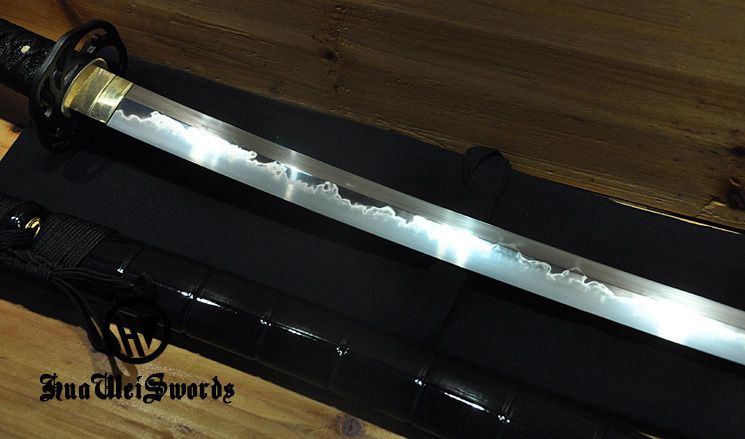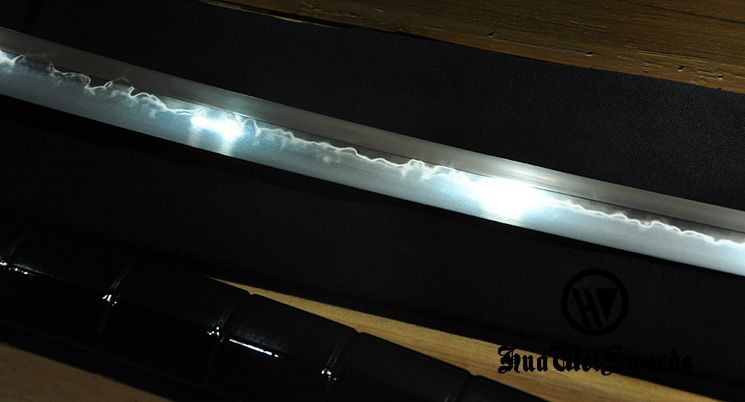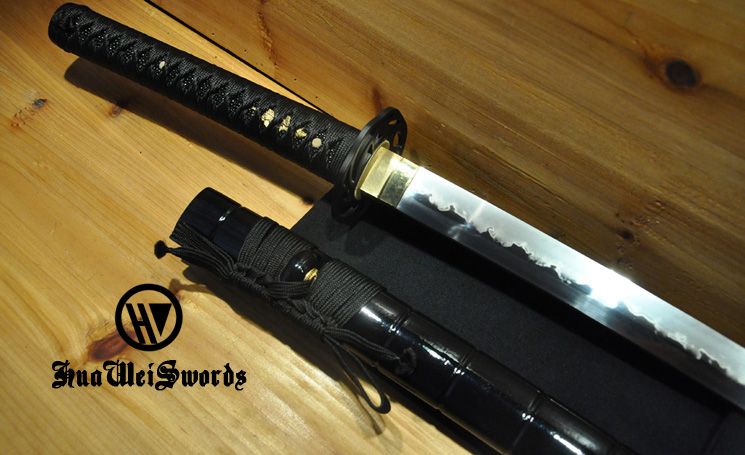|
|
Post by DigsFossils-n-Knives on Jul 1, 2015 13:38:24 GMT
Ruan-sword is still offering these blades, even claiming they are made of tamahagane steel with a hard outer jacket and a softer inner core. Can anyone verify this? All these features plus hand folding and clay tempering sounds too good to be true. areyou satisfied with the one you purchased? Ask for close up pictures of the blade before you buy or before they ship it. Even if someone says it real, don't trust anyone, ask for proof! I'm going to have to work on my "faked sanami" thread and post pics of my recently faked sanmai katana from Ryansword. Too many of these questions are coming up. |
|
|
|
Post by Croccifixio on Jul 2, 2015 3:19:30 GMT
I don't see the lamination line on that ruan. Coupled with the wrong ito wrap, it looks to be just another standard rbay katana (at least it is indeed clay tempered).
|
|
|
|
Post by skurren83 on Jul 4, 2015 9:10:21 GMT
id this a good deal for 400bux?
  

nice structure martensite is it Worth 850bux?
next stage is a tamahagane i saw this blade but the burnishing was sloppy but Everything else looked good tell me what you Think
|
|
|
|
Post by skurren83 on Jul 4, 2015 9:21:49 GMT
here are two more one you can see what I THINK IS SLOPPY BURNISGINF BUT MABY ITS THE LIGHT. sorry caps


its nice Worth 850bux? |
|
|
|
Post by Adrian Jordan on Jul 4, 2015 21:11:04 GMT
Hello.
Huawei have generally come to be seen as a fantastic sword for the prices they ask. Tamahagane is not really superior in functionality to a more common mono steel, such as t10 or 1095, with a good heat treatment, nor is this the super-desired Japanese tamahagane. You are mostly paying for the novelty. If it were me, I'd get the lower priced blade, which looks great, and put the extra $400 into sending it to a customizer for some sprucing up.
|
|
|
|
Post by skurren 83 on Jul 5, 2015 10:33:20 GMT
so i should not sell the 400buc t10 with the choji hamon and then buy a tamahagane its not Worth it?
but if you look from here and up the second Picture can you get that metal strukture with t10?
thwanks for answering i love this hamon on jmy blade i just was thinking the next step it a tamablade o well u saved me 500 smackes almost in that case
|
|
|
|
Post by skurren83 on Jul 5, 2015 10:43:47 GMT
hope everyone undestood i love the ferrite martensite perlite struktere on a real tamahagane there usually att 2000dollars he will part withe the one one the last pics for 850 it also has a choji wich is my favorite but i live in sweden must i send the blade to japan for polishing? you can see the bernishing is sloppy one one pic that should be like a mirror hope you tell me what you Think
kind regards johan
|
|
|
|
Post by Croccifixio on Jul 5, 2015 15:28:28 GMT
If you don't know how well the smith does traditional katana forging (with tamahagane-ish material), then don't bother. Honestly I would only go for a few select US smiths who charge nearly as much as entry level nihonto.
So yeah, I wouldn't risk $850 on that even if it "looks" like tamahagane (and the microstructures mostly need granular cross section to be sure what they are/how well they formed).
|
|
|
|
Post by skurren on Jul 5, 2015 17:54:36 GMT
Hello. Huawei have generally come to be seen as a fantastic sword for the prices they ask. Tamahagane is not really superior in functionality to a more common mono steel, such as t10 or 1095, with a good heat treatment, nor is this the super-desired Japanese tamahagane. You are mostly paying for the novelty. If it were me, I'd get the lower priced blade, which looks great, and put the extra $400 into sending it to a customizer for some sprucing up. do you Think i need to spruce up the blade in the 2 firt Pictures that a brand new blade that i own now the question was shuol i sell it and buy the blade in the other pics? that blade need some sprucing in the ju you can clearly see the burnishing tool |
|
|
|
Post by skurren on Jul 5, 2015 17:59:46 GMT
If you don't know how well the smith does traditional katana forging (with tamahagane-ish material), then don't bother. Honestly I would only go for a few select US smiths who charge nearly as much as entry level nihonto. So yeah, I wouldn't risk $850 on that even if it "looks" like tamahagane (and the microstructures mostly need granular cross section to be sure what they are/how well they formed). can you Point me in the right direction so i can find these blades praying mantis is that a good one maby i stick with the one i have its the most beutiful hamon iv seen AND I OWN IT  BUT PLEASE POINT IN ninhonto level so o can see dose blades thank you for answering |
|
|
|
Post by Adrian Jordan on Jul 5, 2015 19:18:10 GMT
No, the first blade looks fine to me. I was talking more about getting any fittings you may want swapped out for exactly ones you want, or having the saya rattan wrapped, or anything like that. If it's already too your liking, then that's even better, hahaha.
As for the marks on the blade you showed before, I believe that may possibly have something to do with the lighting. Blades that look flawless under most light will show marks like that under bright, unforgiving light, at least to a certain degree, and especially with production piece. Then again, it may just look like that. One of the downfalls of not being able to handle and examine a sword in person.
In the end, remember that this isn't mine or anybody but your sword. If you want the tamahagane, go for it. It's your money, and your enjoyment to be had. It won't explode because it's not made from traditional Japanese tatara smelted tamahagane, hahaha. The extra funds you employ may be small bones compared to the pleasure you get out of the sword. Either way, I hope you enjoy it!
|
|
|
|
Post by Adrian Jordan on Jul 5, 2015 19:23:26 GMT
As for viewing Nihonto, a lot of sites have great pictures. Nihonto Message Board, Aoi Art, The Samurai Sword. You can also look up polishers(called toshigi in Japanese) like Chris Osbourne and David Hofhine. They will often have great photos.
|
|
|
|
Post by skurren on Jul 6, 2015 12:24:10 GMT
THANK YOU i got the t10 today its soooo beutiful and Everything is flawless i love how it handles and probably this is a keeper 1 question differens between nihontō and katan? tank you CHOJI HAMON RULES  |
|
|
|
Post by skurren83 on Jul 6, 2015 12:32:02 GMT


I LOVE IT my camera sux so i used the Sellers pics but it is the sword on the pics i compeard the hamon and its har to do it twice exactly ;D |
|
|
|
Post by Adrian Jordan on Jul 6, 2015 20:22:26 GMT
A nihonto is a sword made wholly from Japanese materials, by a certified Japanese smith, in Japan. It likely will be papered by the Japanese government. There are very strict rules governing the making and distribution of them.
A katana is any sword in that style, but doesn't need to be made using the same rules and traditions as a nihonto, and it can be made anywhere by anyone.
|
|
|
|
Post by Anankai on Jul 6, 2015 21:12:09 GMT
Got to get one from Huawei someday... Just a pity the quality of the fittings is not on par with the quality of the blade. Still, they're not that bad either.
|
|
|
|
Post by skurren okey on Jul 7, 2015 11:10:38 GMT
but if a ninhonto is regsrded as a "reasure" the must make it in fine materials ju just´want a genuine ninhonto and made as the tradisinal ways this t10 is waterstone 16 types and the fingerstones and something to get the hamon that ghostly whitish color.
|
|
|
|
Post by Adrian Jordan on Jul 7, 2015 19:45:49 GMT
In Japan, swords are considered a part of their cultural heritage. They are regulated, and you must jump through hoops to acquire a license to own one there. They are indeed made from high quality materials, and you pay a premium for them. Due to the restrictions that are placed on the smiths and buyers, the craft of making them is no longer flourishing, nor are the other trades associated with it, like polishers and fitting makers.
The polishing of a nihonto and the polishing of a modern replica like many of us buy are completely different. The steels react very differently to the stones used by traditional polishers, and a real polish by a professional polisher can cost thousands of dollars. Most production swords are polished by machines and lower skilled laborers using things like sandpaper, buffing wheels and acids to etch in order to save money. Some, like Huawei, have gotten pretty dang good at it, as evidenced by your sword.
|
|
|
|
Post by skurren on Jul 8, 2015 8:21:01 GMT
thank you Adrian for making Everything clear but he told me that my blade was sharpend and polished by japanese waterstones 16 diferent but mabythe dont cost 1000@ but they did a awesome job i can staar at this blade four an houre the hamon is sooo aahh i have no Words and the fittings as superb tight as hell and good material the saya almost have av vacume when you Close it so his fittings are 5 stars..
rhank you everybody and i shall get my selt an ninhonto some day in the future
|
|
|
|
Post by Croccifixio on Jul 8, 2015 10:04:59 GMT
Even if it's made of japanese tamahagane, polished with japanese waterstones by a japanese trained polisher, and looks exactly like a japanese-made sword, if it wasn't made by a sanctioned japanese smith, then it's not nihonto. Those restrictions plus the centuries old artistic polishing tradition make nihonto probably the most expensive swords right now.
|
|

